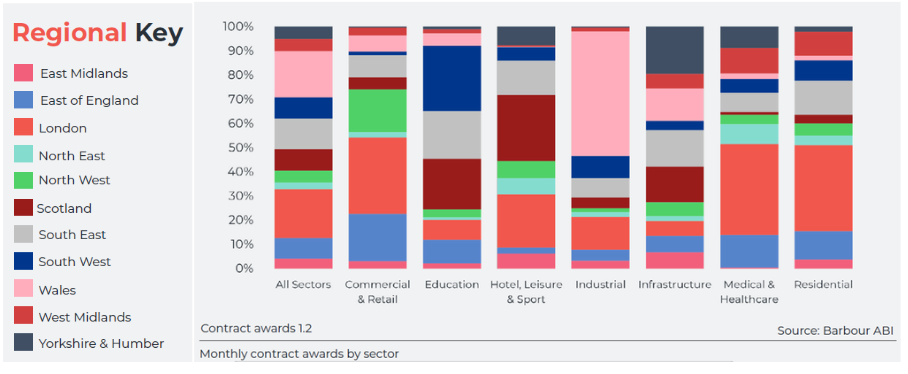UK Construction contract spending up 69 percent at the start of 2025
UK Construction contract spending is up 69% in the first month of the new year of 2025.
- Positive news following a bleak purchasing managers’ index (PMI Index) report in early February
- New construction orders reached nearly 8.4bn in January
- Residential contracts up £900billion on December
- Infrastructure projects remain a key comment in 2025 predictions
Spending on new construction orders reached nearly 8.4bn in January in an upbeat start to the year for construction – a 69% increase on December. The analysis follows analysis in the last month of the year from Barbour ABI that contract awards were up 15% up in 2024.
The figures provide a silver lining after the S&P Global purchasing managers’ index (PMI) showed a fall in on-the-ground construction output in January.
The residential sector bounced back from a disappointing finish to 2024 to see a January total of just under £2.5bn, up £900million on previous month. A £180million development at Devonshire Garden in Cambridge led the surge with Morgan Sindall set to carry out the works.
Meanwhile infrastructure awards were up 7% on previous month and 13% on same month last year. The renewable energy sector played a role including contracts awarded at Immingham Green Energy Terminal at a cost of £170m.
“A great start to the year with contract awards augurs well for 2025,” said Barbour ABI Head of Business and Client Analytics, Ed Griffiths. “This suggests that the downturn highlighted in the recent PMI index could be short-lived, with new work on the horizon.
“A further fall in interest rates announced this week will also add to increased confidence from investors, although the news is tempered by a fall in projected UK GDP. Although growth is expected for 2025 it will be at the lower end in the built environment.”
Meanwhile the latest planning application figures remained flat with a 2% increase between November and December 2024. Although there was little movement overall, individual sectors did see significant rise and falls.
December was a strong month for the infrastructure sector with a 35% increase in the value of applications. The top application was the 840MW Botley West Solar Project. The North East saw a strong recovery from a weak November rising to £540m. The largest application was a 1000MW Battery Storage Project.
“Our recent industry performance review highlighted how infrastructure sustained the sector in 2024. Planning applications at year-end suggest this trend could continue into 2025, with green energy at the forefront,” said Griffiths.
“However, uncertainty remains high, and the industry will be hoping that falling interest rates finally lead to an increase in project submissions.”
[edit] Related articles on Designing Buildings
- Construction contract awards provide relief in the wake of ISG collapse
- Construction contract awards jump to £7.3bn in May as uncertainty continues
- Construction industry revs engines in January
- Election fails to spark construction industry revival
- Government construction and infrastructure pipelines.
- Green infrastructure.
- Growth and Infrastructure Act.
- Homeowners turn to green energy upgrades as home improvement activity declines
- Infrastructure and Projects Authority.
- Infrastructure UK (IUK).
- Infrastructure nationalisation.
- Infrastructure tumbles, adding to construction industry woes
- London construction cools as hotspots appear nationally
- London infrastructure plan.
- National Infrastructure Pipeline.
- National Infrastructure Plan.
- Nationally Significant Infrastructure Projects.
- New energy rules, a threat to towns and cities across UK
- Planning approvals increased by 20% in June ahead of Labour’s new drive for housebuilding
- Residential takes the reins from infrastructure as contract awards even out
- Resilience of UK infrastructure and climate predictions.
- Smart cities.
- Subdued planning environment figures provide scant hope for house-building targets
- The future of green infrastructure.
- Traffic and transport.
Featured articles and news
Latest Build UK Building Safety Regime explainer published
Key elements in one short, now updated document.
UKGBC launch the UK Climate Resilience Roadmap
First guidance of its kind on direct climate impacts for the built environment and how it can adapt.
CLC Health, Safety and Wellbeing Strategy 2025
Launched by the Minister for Industry to look at fatalities on site, improving mental health and other issues.
One of the most impressive Victorian architects. Book review.
Common Assessment Standard now with building safety
New CAS update now includes mandatory building safety questions.
RTPI leader to become new CIOB Chief Executive Officer
Dr Victoria Hills MRTPI, FICE to take over after Caroline Gumble’s departure.
Social and affordable housing, a long term plan for delivery
The “Delivering a Decade of Renewal for Social and Affordable Housing” strategy sets out future path.
A change to adoptive architecture
Effects of global weather warming on architectural detailing, material choice and human interaction.
The proposed publicly owned and backed subsidiary of Homes England, to facilitate new homes.
How big is the problem and what can we do to mitigate the effects?
Overheating guidance and tools for building designers
A number of cool guides to help with the heat.
The UK's Modern Industrial Strategy: A 10 year plan
Previous consultation criticism, current key elements and general support with some persisting reservations.
Building Safety Regulator reforms
New roles, new staff and a new fast track service pave the way for a single construction regulator.
Architectural Technologist CPDs and Communications
CIAT CPD… and how you can do it!
Cooling centres and cool spaces
Managing extreme heat in cities by directing the public to places for heat stress relief and water sources.
Winter gardens: A brief history and warm variations
Extending the season with glass in different forms and terms.
Restoring Great Yarmouth's Winter Gardens
Transforming one of the least sustainable constructions imaginable.

























